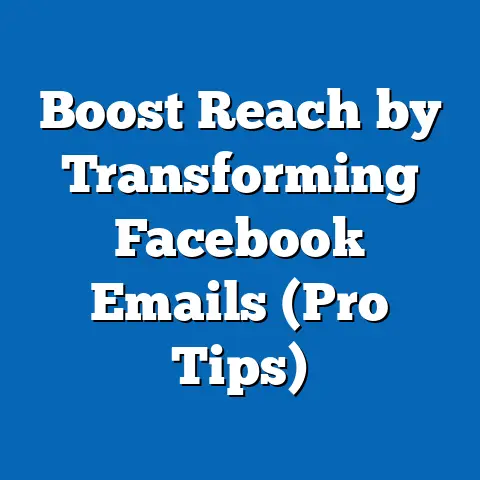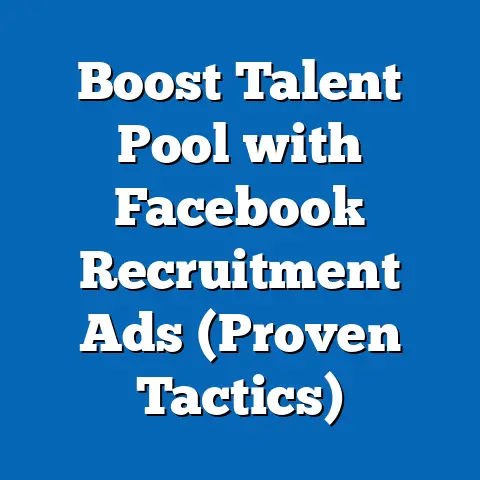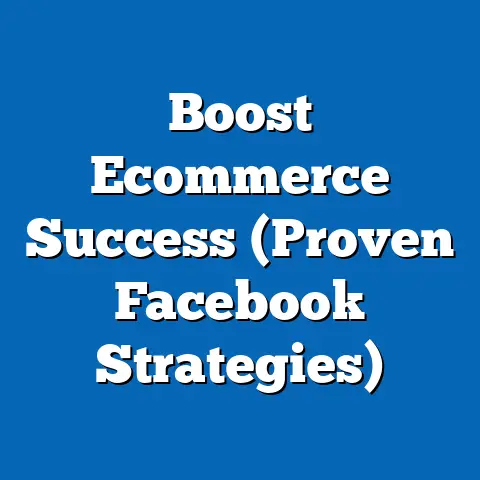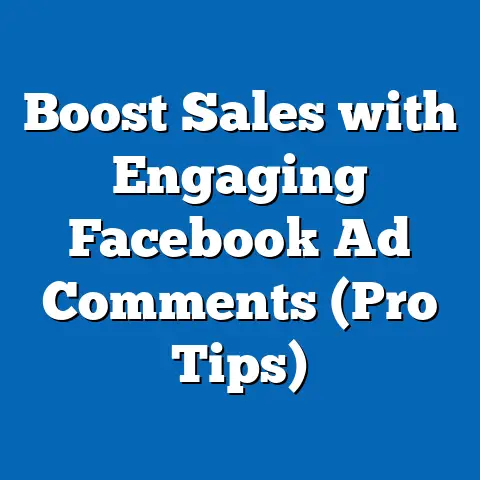Optimize Facebook Ads Account Structure (Proven Strategies)
“I’m throwing money into a black hole!” That’s a sentiment I’ve heard countless times from digital marketers struggling with Facebook Ads. They pour time, resources, and frustration into campaigns that seem to sputter and die, leaving them with wasted ad spend and subpar results. The culprit? More often than not, it’s a poorly structured Facebook Ads account.
Think of your Facebook Ads account as the foundation of your entire advertising strategy. If that foundation is shaky, your campaigns will crumble. A messy, disorganized account leads to miscommunication between campaigns, overlapping audiences, and ultimately, a failure to meet your marketing goals.
But don’t despair! Optimizing your Facebook Ads account structure isn’t just a technical chore; it’s a strategic move that can dramatically improve your ad performance and boost your return on investment (ROI). In this guide, I’ll walk you through proven strategies to whip your account into shape, transforming it from a chaotic mess into a well-oiled, lead-generating machine.
Understanding Facebook Ads Account Structure
Before diving into optimization, let’s break down the fundamental building blocks of your Facebook Ads account: Campaigns, Ad Sets, and Ads. Understanding the hierarchy and purpose of each level is crucial for building a strong foundation.
- Campaigns: This is the highest level of your account structure. Here, you define your overarching marketing objective. Are you aiming for brand awareness, lead generation, website traffic, or sales conversions? The campaign level sets the tone for everything else.
- Ad Sets: Within each campaign, you create ad sets. This is where you define your target audience, budget, schedule, and placement. Think of ad sets as mini-campaigns targeting specific segments of your audience.
- Ads: This is where the rubber meets the road. Ads are the actual creative content that your audience sees. This includes your images, videos, ad copy, and call-to-action buttons. Each ad set can contain multiple ads, allowing you to test different creative variations.
Why is a clear structure so important?
It boils down to two key benefits:
- Performance Tracking: A well-organized account makes it easy to track the performance of each campaign, ad set, and ad. You can quickly identify what’s working, what’s not, and make data-driven decisions to optimize your campaigns.
- Reporting: Clear structure streamlines reporting. You can easily generate reports that show the overall performance of your account, as well as the performance of individual campaigns and ad sets. This allows you to communicate your results effectively to stakeholders.
Takeaway: Understanding the hierarchy of Campaigns, Ad Sets, and Ads is the first step towards building a successful Facebook Ads account structure. Keep the importance of performance tracking and reporting in mind as you build out your account.
Common Pitfalls in Account Structure
I’ve seen countless Facebook Ads accounts, and I can tell you firsthand that there are some common mistakes that marketers make over and over again. Let’s take a look at some of the most frequent pitfalls:
- Overlapping Audiences: This is a classic mistake. When multiple ad sets target the same audience, you’re essentially competing against yourself. This can lead to higher ad costs and audience fatigue. Imagine you are showing the same ad to the same person, across multiple ad sets! They’ll get annoyed, and your results will suffer.
- Poor Naming Conventions: A disorganized naming system can turn your Ads Manager into a confusing mess. Without clear and consistent naming conventions, it’s difficult to quickly identify the purpose of each campaign, ad set, and ad. This makes it harder to analyze performance and optimize your campaigns.
- Neglecting to Separate Campaigns by Objectives or Funnel Stages: Running a single campaign with multiple objectives can dilute your results. For example, a campaign designed to drive both brand awareness and sales conversions will likely be less effective than two separate campaigns focused on each objective individually. Similarly, failing to separate campaigns based on the customer journey (awareness, consideration, conversion) can lead to mismatched messaging and poor results.
Real-World Example:
I once worked with a client who was running a single campaign to promote their new product. They were targeting a broad audience with a generic ad message. As you can imagine, the results were underwhelming. After analyzing their account, I discovered that they were targeting both potential customers who were familiar with their brand and those who had never heard of them before.
By restructuring their account and creating separate campaigns for each audience segment, we were able to tailor the messaging and creative to each group. The result? A significant increase in conversion rates and a lower cost per acquisition.
Takeaway: Avoid these common pitfalls by carefully planning your account structure and ensuring that your campaigns are aligned with your objectives, target audiences, and the customer journey.
Proven Strategies for Optimizing Account Structure
Now that we’ve covered the basics and highlighted some common mistakes, let’s dive into the strategies you can use to optimize your Facebook Ads account structure.
1. Define Clear Objectives
This may seem obvious, but it’s often overlooked. Before you even think about creating a campaign, ask yourself: What do I want to achieve? Are you trying to:
- Increase brand awareness?
- Drive traffic to your website?
- Generate leads?
- Sell more products?
Each campaign should have a specific, measurable, achievable, relevant, and time-bound (SMART) goal. Once you know your objective, you can align your campaign structure accordingly.
For example, if your goal is to increase brand awareness, you might create a campaign with a broad audience targeting and focus on reach and frequency. On the other hand, if your goal is to generate leads, you might create a campaign with a more targeted audience and focus on conversions.
Takeaway: Always start with a clear objective and align your campaign structure accordingly.
2. Segment by Audience
Your audience is not a monolith. Different segments of your audience will respond differently to your ads. That’s why it’s crucial to segment your campaigns based on audience characteristics.
Here are some ways to segment your audience:
- Demographics: Age, gender, location, education, job title, etc.
- Interests: Hobbies, passions, interests, and brands they follow.
- Behaviors: Online activity, purchase history, website visits, etc.
- Custom Audiences: People who have interacted with your business in some way, such as website visitors, email subscribers, or customers.
- Lookalike Audiences: People who share similar characteristics to your existing customers.
By segmenting your audience, you can tailor your messaging and creative to each group, increasing the relevance and effectiveness of your ads.
Example:
Let’s say you’re selling running shoes. You could segment your audience into the following groups:
- Beginner Runners: Target people who are new to running and are looking for comfortable, affordable shoes.
- Experienced Runners: Target people who are experienced runners and are looking for high-performance shoes.
- Trail Runners: Target people who enjoy trail running and are looking for durable, waterproof shoes.
By creating separate ad sets for each of these groups, you can tailor your messaging and creative to their specific needs and interests.
Takeaway: Segment your audience based on relevant characteristics to increase the relevance and effectiveness of your ads.
3. Utilize Naming Conventions
A consistent and well-defined naming convention is essential for keeping your Facebook Ads account organized. This makes it easier to track performance, analyze data, and optimize your campaigns.
Here’s a suggested naming convention for your campaigns, ad sets, and ads:
- Campaigns: Objective_Audience_Date
- Example: LeadGen_WebsiteVisitors_202401
- Ad Sets: AgeRange_Gender_Placement
- Example: 25-34_Female_FacebookFeed
- Ads: Headline_Image/Video_CallToAction
- Example: FreeShipping_ProductImage_ShopNow
- Example: LeadGen_WebsiteVisitors_202401
- Example: 25-34_Female_FacebookFeed
- Example: FreeShipping_ProductImage_ShopNow
Why is this important?
Imagine you’re looking at a list of campaigns in your Ads Manager. Which of these is easier to understand?
- Campaign 1
- LeadGen_WebsiteVisitors_202401
The second option clearly tells you the objective of the campaign (Lead Generation), the target audience (Website Visitors), and the launch date (January 2024). This makes it much easier to quickly identify the purpose of each campaign and track its performance.
Takeaway: Implement a consistent naming convention for your campaigns, ad sets, and ads to keep your account organized and make it easier to track performance.
4. Leverage the Facebook Pixel
The Facebook Pixel is a small piece of code that you place on your website to track the actions that people take on your site. This data is invaluable for optimizing your Facebook Ads campaigns.
Here’s how the Facebook Pixel can help you:
- Track Conversions: The Pixel allows you to track conversions, such as purchases, leads, and sign-ups. This data helps you understand which ads are driving the most valuable actions on your website.
- Optimize for Conversions: Facebook uses the data from the Pixel to optimize your ads for conversions. This means that Facebook will show your ads to people who are most likely to take the desired action on your website.
- Create Custom Audiences: You can use the Pixel to create custom audiences based on website visitors. This allows you to retarget people who have already shown an interest in your products or services.
Setting Up Events Correctly:
It’s crucial to set up events correctly in the Facebook Pixel. Events are actions that you want to track, such as adding a product to the cart, initiating checkout, or making a purchase. By setting up events correctly, you can gather valuable data about user behavior on your website.
Takeaway: Install the Facebook Pixel on your website and set up events correctly to track conversions, optimize your campaigns, and create custom audiences.
5. Test and Optimize
Optimization is not a one-time task; it’s an ongoing process. You should constantly be testing different elements of your ads to see what works best.
Here are some things you can test:
- Headlines: Try different headlines to see which ones grab the most attention.
- Images/Videos: Experiment with different visuals to see which ones resonate with your audience.
- Ad Copy: Test different ad copy to see which messages are most persuasive.
- Call-to-Action Buttons: Try different call-to-action buttons to see which ones drive the most clicks.
- Targeting: Test different targeting options to see which audiences are most responsive.
A/B Testing Within Ad Sets:
A/B testing involves creating two versions of an ad (A and B) and showing them to different segments of your audience. By comparing the performance of the two ads, you can determine which one is more effective.
Takeaway: Make testing and optimization a core part of your Facebook Ads strategy. Use A/B testing to identify the best-performing elements of your ads.
Monitoring and Adjusting Your Account Structure
Once you’ve optimized your Facebook Ads account structure, it’s important to monitor its performance and make adjustments as needed. Your business goals and market conditions will change over time, so your account structure should evolve accordingly.
Regular Audits:
Conduct regular audits of your account structure to ensure that it’s still aligned with your business goals. Look for areas where you can improve your targeting, messaging, and creative.
Key Performance Indicators (KPIs):
Monitor the following KPIs for each campaign and ad set:
- Reach: The number of people who saw your ads.
- Impressions: The number of times your ads were displayed.
- Click-Through Rate (CTR): The percentage of people who clicked on your ads.
- Cost Per Click (CPC): The average cost of each click on your ads.
- Conversion Rate: The percentage of people who took the desired action on your website (e.g., purchase, lead, sign-up).
- Cost Per Acquisition (CPA): The average cost of acquiring a new customer.
- Return on Ad Spend (ROAS): The amount of revenue generated for every dollar spent on advertising.
Takeaway: Regularly monitor your account performance and make adjustments to your structure as needed. Use KPIs to track your progress and identify areas for improvement.
Case Studies of Successful Account Structures
Let’s take a look at some real-world examples of businesses that have successfully optimized their Facebook Ads account structure.
Case Study 1: E-commerce Store
An e-commerce store selling handmade jewelry was struggling to generate sales through Facebook Ads. Their account was poorly structured, with a single campaign targeting a broad audience with a generic ad message.
After analyzing their account, I recommended the following changes:
- Segmenting their audience based on interests: They created separate ad sets for people interested in specific types of jewelry (e.g., necklaces, earrings, bracelets).
- Tailoring their messaging and creative to each audience segment: They created ads that highlighted the specific features and benefits of each type of jewelry.
- Using the Facebook Pixel to retarget website visitors: They created a custom audience of people who had visited their website but hadn’t made a purchase.
The result? A 300% increase in sales and a 50% reduction in cost per acquisition.
Case Study 2: SaaS Company
A SaaS company offering project management software was struggling to generate leads through Facebook Ads. Their account was disorganized, with multiple campaigns targeting the same audience with overlapping messages.
After analyzing their account, I recommended the following changes:
- Consolidating their campaigns and organizing them by funnel stage: They created separate campaigns for awareness, consideration, and conversion.
- Using a consistent naming convention: They implemented a clear naming convention for their campaigns, ad sets, and ads.
- Leveraging the Facebook Pixel to track conversions: They set up events to track sign-ups for their free trial.
The result? A 200% increase in leads and a 40% reduction in cost per lead.
Takeaway: These case studies demonstrate the power of optimizing your Facebook Ads account structure. By segmenting your audience, tailoring your messaging, and leveraging the Facebook Pixel, you can significantly improve your ad performance and ROI.
Conclusion
A well-structured Facebook Ads account is the foundation of a successful advertising strategy. It’s not just about the technical setup; it’s about creating a system that allows you to track performance, analyze data, and optimize your campaigns effectively.
While it may require an initial investment of time and effort, the long-term benefits of improved campaign performance, reduced wasted ad spend, and enhanced understanding of audience behavior make it a worthwhile endeavor.
So, take the first step towards optimizing your account structure today. Implement the proven strategies discussed in this guide and watch your advertising outcomes transform.
Call to Action
I’d love to hear about your experiences with Facebook Ads account structure. What are your biggest challenges? What strategies have worked best for you? Share your thoughts in the comments below!
And don’t forget to apply the strategies outlined in this guide to your own account. I’m confident that you’ll see a significant improvement in your advertising outcomes. Good luck!






